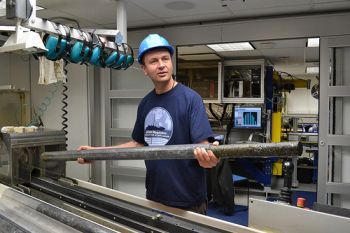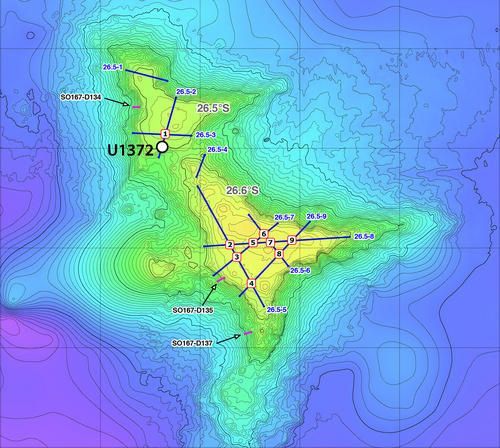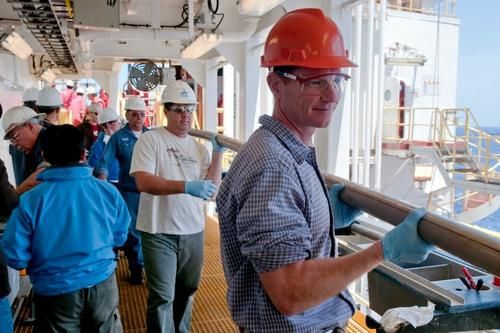
Publisher:
Bonnie King
CONTACT:
Newsroom@Salem-news.com
Advertising:
Adsales@Salem-news.com

~Truth~
~Justice~
~Peace~
TJP
Nov-25-2012 11:44

 TweetFollow @OregonNews
TweetFollow @OregonNews
New Study Finds Major Differences in Deep Earth Motions of Volcanic 'Hotspots'
By Mark Floyd for Salem-News.comKoppers was able to date the volcanoes’ ages by looking at the argon isotope ratios of gas trapped within the rocks.
 Anthony Koppers, an Oregon State University marine geologist |
(CORVALLIS, OR) - The movement of tectonic plates over a volcanic hotspot typically results in a narrow chain of seamounts, such as the Hawaiian-Emperor Seamount Trail. This hotspot trail is fed by a deep-mantle plume, which scientists believe drifted 15 degrees southward over millions of years because of a Pacific Ocean-wide “mantle wind.”
But a new study that analyzes the Louisville hotspot in the southern Pacific Ocean found very little drift of its mantle plume, suggesting it is moving independently of its Hawaiian counterpart, and not as part of a large-scale mantle wind.
Results of the study, which was funded by the National Science Foundation through the International Ocean Drilling Program, were published today in Nature Geoscience.
“This is only the second major hotspot system that has been fully analyzed and it finally gives us something to compare to the Hawaiian hotspot,” said Anthony Koppers, an Oregon State University marine geologist and lead author on the study. “It appears that there is no global mantle wind, which means the whole of the Pacific mantle doesn’t move in a synchronous way.”
 |
“The Earth is a unique planet because of its plate tectonics and there is much we still do not understand about the dynamic processes happening in its deep interior,” added Koppers, an associate professor in OSU’s College of Earth, Ocean, and Atmospheric Sciences. “We’re just starting to document how some of these major volcanic chains formed, and how their mantle sources moved over geological time.”
In 2003, a study by Robert Duncan of OSU and John Tarduno of the University of Rochester concluded that the Hawaiian Islands had drifted 1,600 to 1,800 kilometers from north to south – in a direction and at a speed that wasn’t consistent with the movement of the tectonic plate. Most of the drift occurred 50 million to 80 million years ago. They attributed it to the mantle wind or the influence of a nearby mid-ocean spreading center that can capture a plume and divert it from its track.
It has taken nearly a decade for scientists to analyze a second volcanic hotspot, Koppers said, because the logistics of such a study are daunting. To analyze and date the volcanoes, the researchers had to drill through as much as 1,400 meters of hard basement rock located some 1-2 kilometers beneath the surface of the Pacific Ocean in the Southern Hemisphere.
“It was,” said Koppers, “a record for the Integrated Ocean Drilling Program.”
What the researchers found was that the Louisville hotspot between 50 million to 70 million years ago drifted very little from its original location – perhaps only 3 degrees from north to south. The reason, Koppers speculates, is that there were no adjacent mid-ocean spreading centers located to the north of the Louisville hotspot to pull its mantle plume off course.
 |
Koppers specializes in the study of how the inner Earth moves. He was able to date the volcanoes’ ages by looking at the argon isotope ratios of gas trapped within the rocks. He and his colleagues found that the Louisville and Hawaiian chains formed new volcanoes every one million to three million years.
“What is interesting is after a time, the mantle wind more or less disappeared for Hawaii,” Koppers said. “Most of the drift took place during the first 30 million years then it looks like the hotspot moved far enough away from the spreading center to lose that influence. When we looked at the Louisville movement over the last 50 million years, it seems very similar to that of Hawaii during the same period.”
Koppers said the researchers hope to next study the Walvis Ridge volcanic chain in the Atlantic Ocean off South Africa – another long-lived seamount trail, but in another ocean.
“This is fundamental yet important research because it is becoming apparent that no one theory explains the formation of all of Earth’s 125,000 or so seamounts,” Koppers said.
IODP Expedition 330 Louisville Seamount Trail - Video Archive
IODP Expedition 330 Louisville Seamount TrailProbing Wandering Mantle Plumes in the Pacific Ocean
Special thanks to Mark Floyd and Oregon State University
 |
 |
 |
Articles for November 24, 2012 | Articles for November 25, 2012 | Articles for November 26, 2012
Quick Links
DINING
Willamette UniversityGoudy Commons Cafe
Dine on the Queen
Willamette Queen Sternwheeler
MUST SEE SALEM
Oregon Capitol ToursCapitol History Gateway
Willamette River Ride
Willamette Queen Sternwheeler
Historic Home Tours:
Deepwood Museum
The Bush House
Gaiety Hollow Garden
AUCTIONS - APPRAISALS
Auction Masters & AppraisalsCONSTRUCTION SERVICES
Roofing and ContractingSheridan, Ore.
ONLINE SHOPPING
Special Occasion DressesAdvertise with Salem-News
Contact:AdSales@Salem-News.com

googlec507860f6901db00.html



Terms of Service | Privacy Policy
All comments and messages are approved by people and self promotional links or unacceptable comments are denied.
[Return to Top]
©2025 Salem-News.com. All opinions expressed in this article are those of the author and do not necessarily reflect those of Salem-News.com.